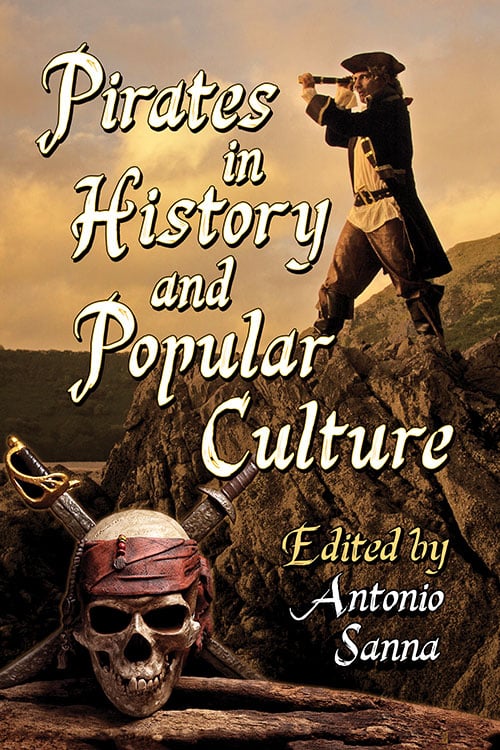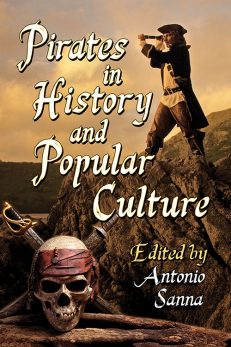Introduction 1
Part I: Pirates in History
Historical and Fictional Pirates: A Review (Antonio Sanna) 7
Piratical Societies as the Blueprint for Social Utopia (Clint Jones) 25
A Pirate Business Model (Christopher Ketcham) 37
Swashbuckling Sexuality: The Problem with Queer Pirates (Nick Marsellas) 50
“The Boy-Sublime”: Sir Lionel Lindsay and Piracy (Jayson Althofer and Brian Musgrove) 61
Part II: Pirates in Literature
Sea-Wolves, Smugglers and Seascapes: Captain Cruel Coppinger and Criminality in Cornwall (Joan Passey) 75
Piratical Identity, Antarctic Solitude and Stolen Treasure in The Frozen Pirate (Minke Jonk) 88
Pirates and Orphans in Literature: From Victorian Boys’ Books to James Barrie’s Peter Pan (Eurydice Da Silva ) 98
Really Romantic? Pirates in Romantic Fiction (Racheal Harris) 109
“Yo-ho-ho and a bottle of rum”: Representations of Drunkenness in Literary and Cinematic Narratives on Pirates (Antonio Sanna) 120
Part III: Pirates in Cinema and on TV
The Image of the Pirate in Adaptations of The Adventures of Tintin (Michael Charlton) 133
Masculine Ideal/Cultural Treasure: Long John Silver in Treasure Planet (Sue Matheson) 144
“What would the world be like without Captain Hook?”: A Freudian Analysis of Our Love for (Anti-)Villains (Tiago A.M. Sarmento) 155
“Take what you can …”: Disney’s Jack Sparrow and His Indebtedness to the Pirate Genre (Susanne Zhanial) 167
Civilization’s Monsters: The Doomed Queer Anti-Imperialism of Black Sails (Jessica Walker) 178
Part IV: Pirates in Other Media
The Servant, the Sinner and the Savior: The Pirate in Early Nineteenth Century Italian Opera (Alexandra V. Leonzini) 187
The Humorous, Sarcastic Case of the Pastafarian Pirates (Jeff Parish) 200
“Gay and brisk”: Constructing a Pirate’s Image for Children (William Newton) 213
Being a Pirate: The Use and Purpose of a Piratical Setting in Rum & Bones (Nicholas Moll) 225
Pirate as Homo Ludens: Analyzing the Humorous Outlaw at Play in One Piece (Artur Skweres) 236
About the Contributors 247
Index 251
Review Fix chats with Pirates in History and Popular Culture author Antonio Sanna to find out why people love pirates so much and how his research dispels the myths and allure of the character to reveal some awesome truths.
Review Fix: What inspired the creation of this book?
Antonio Sanna: I have always liked the figure of the pirate. I remember playing with the Playmobil pirate vessel when I was a child and dressing up as a pirate at Carnival (an experience many of you may have probably shared). The project of this book came from the idea to write a review of On Stranger Tides, the fourth film in the Pirates of the Caribbean saga. I ordered and read the homonymous 1987 volume by Tim Power the film was adapted from in order to compare the two works. Power’s book is a great novel: its compelling narrative makes abundant use of supernatural thematics (including voodoo, magic, resuscitation spells, and zombie crews) while narrating the search for the Fountain of Youth. Power mingles historical characters such as Blackbeard with the fictional events depicting the seawolves as ruthlessly addicted to violence and obscene language. This led me to do some research on historical pirates and, simultaneously, on their fictional counterparts, until I realized that an academic study of the figure of the pirates in both its real and fictional incarnations was lacking on the present market. I therefore sent out the call for papers to look for people who were likewise motivated to dig into such a compelling subject and bring forth new interpretations of it.
Review Fix: What makes Pirates worthy of a book like this in your opinion?
Sanna: Fascination with pirates, their looks and habits, as well as their nefarious actions that span the seas of the entire globe, is an established phenomenon in contemporary culture that has rarely ceased to capture public attention since the 17th century. Many of you (no matter what country or culture you belong to) will be able to mention at least three or four names of historical or fictional pirates, which indicates that they are firmly rooted in the popular consciousness and imagination. However, few people will immediately realize that such an interest in the high-sea godless outlaws of the past has been shared by hundreds of writers and directors throughout the last three centuries. Most importantly, the most sordid and cruel aspects that characterize the historical pirates have been dismissed in favor of a romanticized version, one that portrays the typical sea marauder as an antiheroic adventurer and noble outlaw. This collection of twenty original essays traces the development of the figure of the pirate from history (especially during the “golden age of piracy”, which has been dated around 1660-1730) to its representation in past and contemporary media, from literature, cinema and television to opera, anime, toys and religion.
Review Fix: What was the writing process like?
Sanna: Since I have an education in English literature and a life-long interest in cinema (that was cultivated in academic terms after my PhD in London), this book became a natural corollary and blend of my previous studies and my passion for films. Reading the primary sources has been an intense pleasure and watching the films on pirates released since the 1920s has been a valuable addition to my knowledge of the main genres I had previously dedicated my attention to (horror, science fiction and adaptations of literary works).
I found the collaboration with the various contributors very helpful and instructive. Working with people around the globe is a very rewarding process that forms some new working relationships enduring even after the publication of the volume itself. I had indeed the pleasure to collaborate again with some of these contributors for other volumes I edited later and have kept in contact with them regularly. I enjoyed the communication with the contributors because we established an in-joke among us from the very first emails: I addressed them as my crew and was addressed by them as their captain. I told them about the publication process through metaphors referring to the world of piracy (in our correspondence boarding a vessel was the equivalent of contacting a publisher, for example). This really helped to establish a serene working atmosphere throughout the writing and publication process.
On the other hand, a few people who contacted me initially and proposed to write an essay dropped out of the project unexpectedly (or even without bothering to reply to my emails requesting an update on their part). As editors of collections will probably know, this is a very frustrating experience which could delay the publication process at large and can be very annoying for the editor of the book, who has to find and contact other prospective contributors to receive new chapters (or to balance the number of the remaining chapters). This could result in new contributors following a tighter schedule since, by that time, the deadline for the submission of the final manuscript has already been established with the publisher. Asking to be part of a volume and then disappearing “over the horizon” is very disrespectful to the work of all the people who contribute to a book. Real pirates would have been ruthless against such a desertion. 😉
Review Fix: What did you learn through the writing process that you weren’t expecting?
Sanna: I wrote two chapters for this book: they required a lot of research, which led me finally to possess a clear and comprehensive grasp of the subject, although I did not expect such a large quantity of both literary and cinematic material. Many of the books I have read (such as R.M. Ballantine’s 1858 The Coral Island and the 1887 The Frozen Pirate by William Clarke Russell, or more recent works such as Wayne Thomas Batson’s 2007 Isle of Swords and the 2009 Pirate Latitudes by Michael Crichton) as well as many of the films I have watched (such as Wilford Leach’s 1982 The Pirates of Penzance, Steven Spielberg’s 1991 Hook, and the most recent adaptations of Treasure Island) have been welcome surprises and precious additions to my library and collection of DVDs.
As it is often specified throughout the volume, it is difficult to locate all the manifestations of the figure of the pirate and some of the contributors’ essays were enlightening in areas I had not delved into myself, which led me to search for more documents (both written and visual). For instance, Racheal Harris’s essay on pirates in romantic fiction and Alexandra Leonzini’s essay on Italian opera helped me to discover some interesting works I had not read/heard of (or listened to) before. Similarly, Jeff Parish’s chapter on Pastafarianism was extremely instructive. The various interpretations of the literary and cinematographic texts can be instructive especially for scholars of literature and film studies for their rigorous application of academic theories to the subject.
Review Fix: What are your goals for the book?
Sanna: To introduce readers to the different aspects of the figure of the pirate and to demonstrate how the romanticized representation of them that is rooted in today’s popular culture actually derives from nineteenth-century literary depictions and, especially, from the cinematographic productions of the first half of the twentieth century. As many of the essays of this collection demonstrate, historical pirates had instead both positive aspects (their equalitarian community on board, their freedom from the social, heteronormative and class restrictions imposed by the society of the time) and negatives ones (their cruelty and ruthlessness as much as the lack of hygiene aboard, for example).
Review Fix: How would you like it to be remembered?
Sanna: I’d like this book to be remembered as the first academic guide to a study of pirates in popular culture that can inspire other writers to further analyze the subject, especially in some of those nuances that have not completely explored in this volume.
Review Fix: What’s next?
Sanna: I have been recently appointed as the co-editor (with Prof. Adam Barkman of Redeemer College, Canada) of the series Critical Companions to Popular Directors by Lexington Books. I’m therefore working on the next volumes that will be part of the series (so far we have published on Tim Burton and James Cameron, but a volume on Steven Spielberg will be published in Autumn 2019). I am also about to complete an edited volume on Welsh writer Arthur Machen (1863-1947), the father of “weird fiction.” Next, I will be working on my first monograph, on English ghost stories.
Review Fix: Anything else you’d like to add?
Sanna: Thank you very much for your time and attention. I hope you’ll enjoy Pirates in History and Popular Culture, be drawn to further read about the subject and follow all the forthcoming representations of pirates in the different media. Welcome aboard my vessel therefore, let’s set the sails, hoist our colors, and, as (fictional) pirates would say, “shiver me timbers!”





